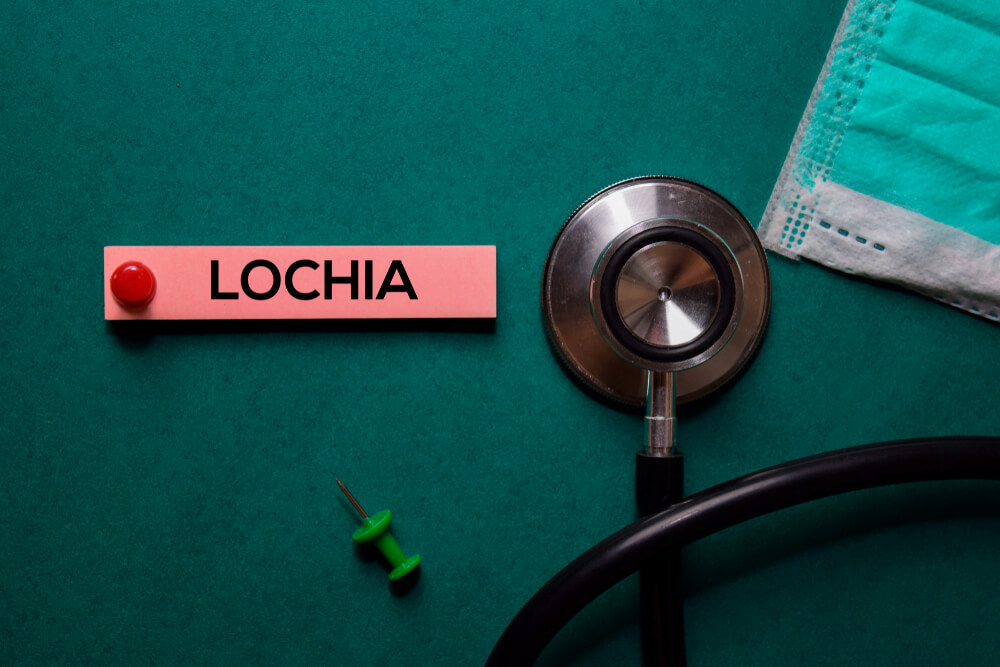Following the excitement and anticipation of childbirth, new mothers often find themselves navigating a myriad of physical changes and adjustments. One such change is Lochia, commonly known as postpartum bleeding. It’s a natural part of the post-birth recovery process, but the lack of widespread knowledge about it can often leave recently delivered mothers puzzled, or even concerned.
The term ‘Lochia’ refers to the vaginal discharge after giving birth, which contains blood, mucus, and uterine tissue. While similar to menstruation, Lochia is a unique process experienced by a woman’s body as it returns to its pre-pregnancy state, shedding the lining that nourishes the baby during gestation.
Understanding Lochia serves as a critical aspect of prenatal education and maternal health care. It is a significant part of the postnatal journey, highlighting the intricacies of the female body and its ability to adapt and recover after the strenuous process of childbirth. To be well informed you need to find a good medical provider, and clinics such as My OBGYN Specialists are the perfect place to start the search.
Healthcare professionals, as well as new and expectant parents, ought to have a comprehensive understanding of Lochia to ensure that the transition to post-pregnancy life is as smooth and as healthy as possible. The knowledge and awareness of postpartum bleeding can be reassuring, helping parents to differentiate between natural body processes and potential health complications.
Armed with the correct information and understanding, new mothers can better navigate this often challenging postnatal period, reducing anxiety and paving the way for a healthier postpartum recovery.
Definition and Basics of Lochia
Lochia, the clinical term for postpartum bleeding or post-delivery bleeding, can be considered the aftermath of pregnancy. It’s the process by which the uterus discharges remnant blood, mucus, and uterine tissue following childbirth. This uterus discharge is natural and a crucial part of postpartum recovery.
Detailed explanation of Lochia
The biological process of childbirth involves changes to the uterus, specifically its lining, to support the growing embryo. Following the delivery, the uterus begins to return to its pre-pregnancy state. This involved process, which leads to the discharge of blood and uterine tissue, is what we refer to as Lochia.
Lochia commences immediately after childbirth, beginning rather heavy but gradually lessening over time. It is different from standard menstruation in its duration, volume, and composition, and is relevant in both natural childbirth and cesarean deliveries. Though it might seem akin to postpartum hemorrhage, Lochia is a natural, expected process, whereas postpartum hemorrhage is an excessive postnatal flow that, if unchecked, could lead to serious health complications.
Various stages and classifications of Lochia
Lochia can be categorized into three stages, each representing a different phase of the postnatal recovery process. Understanding these stages can help mothers and healthcare professionals alleviate any fears of post-birth menstruation being a natural childbirth complication.
The first stage is Lochia Rubra, which takes place immediately after childbirth and can last up to four days. It’s characterized by its bright red color due to the high blood content. The next phase is Lochia Serosa, which occurs between the fifth and the tenth day after delivery.
It is usually pink or brown due to the presence of red blood cells, mucus, and white blood cells. The final stage is Lochia Alba, which begins around the tenth day and lasts up to six weeks post-delivery. It’s generally white or yellow-white due to the reduced number of red cells and the increasing amounts of leukocytes and decidual cells.
Some women might experience a condition known as prolonged Lochia, where the discharge continues beyond the typical timeframe. This can be a sign of retained placental fragments or infection and should be addressed with a healthcare professional.
Causes and Normalcies
While the process of Lochia may seem concerning, it is a natural part of the pregnancy aftermath. It’s essential to understand what triggers this phenomenon and when to seek medical attention in case of deviation from the normal course.

Medical explanations: why does Lochia occur after birth?
During pregnancy, the body prepares the uterine lining to host and nourish the developing baby. The removal and eventual replacement of this lining are what sparked the onset of Lochia. Essentially, post-delivery bleeding is the body’s way of shedding the excess material from the uterus and facilitating the transition back to its pre-pregnancy state.
The blood that forms a significant component of Lochia stems from the site where the placenta separates from the uterine wall post-childbirth. Since this area needs to heal, it starts as a vascular bare area and hence contributes to the bleeding seen in the first phase. Moreover, the contractions and expansions that the uterus undergoes during delivery cause the blood vessels in this region to rupture, further adding to this phenomenon.
What is the normal duration and volume of postpartum bleeding, and when should people worry?
Normal post-birth menstruation typically starts out fairly heavy, dwindles around the tenth day, and ceases within six weeks after birth. The volume of the flow is usually highest immediately post-delivery and slowly decreases over time. However, variations may occur frequently, and it’s always complicated to predict a standard pattern. The main cause for concern is excessive postnatal flow, or Postpartum Hemorrhage, which can lead to dangerous blood loss.
Factors to monitor include unusually large clots, prolonged Lochia lasting beyond six weeks, or a sudden increase in bleeding after it seemed to have reduced. Other red flags could be foul-smelling Lochia, which may indicate an infection, and accompanying symptoms like fever, severe abdominal pain, or dizziness. Such conditions require immediate medical attention and should never be overlooked or normalized.
Recognizing these signs and understanding their implications is an integral aspect of postpartum recovery and maternal healthcare, reducing undue stress and preventing potential complications from escalating.
Care and Precautions
Transitioning to life post-childbirth comes with a row of changes, and managing post-delivery bleeding is a cogent part of this process. Lochia, while a natural process, calls for proper care and attention to prevent postpartum complications.
Personal hygiene and care measures to manage postpartum bleeding
Managing Lochia involves maintaining excellent personal hygiene, as this can prevent potential infections. Using maternity pads rather than tampons is advisable during this period as the latter could introduce bacteria into the vagina, leading to potential health risks. Moms should be prepared to change their pads frequently, especially during the initial stages of post-birth menstruation when the flow is heaviest.
Hydration and a balanced diet can often help in maintaining a healthy uterine environment, aiding a smooth transition back to the pre-pregnancy state. Mothers need to understand that it’s crucial to take the time to rest and recuperate, building up strength and preserving energy vital for both postpartum recovery and neonatal nursing care.
Importance of follow-ups and medical attention
Regular health check-ups and monitoring of postnatal issues can’t be overstated. Regular consultation ensures that the mother’s body is recovering adequately. Maternal healthcare professionals can provide guidance, observe potential deviations or risks, and diagnose conditions such as postpartum hemorrhage or prolonged lochia at the earliest stages. Any deviation from the expected duration or volume of postpartum bleeding should be taken seriously and promptly consulted with a healthcare provider.
Rarely, complicated instances such as excessive postnatal flow, foul-smelling Lochia, or other related symptoms might allude to more complex complications and require immediate medical attention. Even subtler signs should never be neglected, and medical professionals should be notified of any changes that cause discomfort or appear abnormal.
Ultimately, understanding Lochia, being attentive to the body’s changes, and seeking timely medical advice all contribute towards more confident and healthier navigation of the postnatal journey.
Emphasizing Maternal Education and Care in the Postnatal Journey
The journey of new mothers into postnatal life, while exhilarating, can swiftly turn intimidating due to the numerous unanticipated experiences it entails. Lochia, the natural discharge of blood, mucus, and uterine tissue following childbirth, is among those experiences that often remain understated and misunderstood. However, the inclusion of Lochia’s specifics in pre and postnatal education can alter this scenario, reducing the apprehensions and concerns involved.
Awareness about the nature, normal duration, and volume of post-birth menstruation is extremely crucial to distinguish between what is safe and what signals potential complications such as postpartum hemorrhage or prolonged Lochia. Recognizing the signs and maintaining open communication lines with healthcare professionals helps in the early detection and prompt intervention of these problems.
Care for mothers doesn’t stop at childbirth; it extends deep into the postnatal period. Tackling delivery-induced hemorrhage, dealing with lactation disorders, managing post-delivery bleeding, and adjusting to the new routine all require assistance, awareness, and adequate care measures. Personal hygiene, maintaining a balanced diet, and regular follow-ups constitute measures that facilitate a safe and smooth recovery.
In conclusion, childbirth is truly a miraculous journey filled with myriad experiences and challenges. Understanding Lochia is equally essential to gleaning knowledge about pregnancy and childbirth, contributing to comprehensive maternal education and healthcare. Continued efforts to boost this awareness will ensure that mothers enter postnatal life with confidence well prepared to handle what lies ahead.
Hence, new and expecting mothers, along with their caregivers, should be encouraged to garner as much information as possible about Lochia and to dispel doubts or fears with their healthcare providers. Reach out to our clinic anytime if you want to find out more information about this condition because whatever the journey might entail, it is significant to remember that every mother deserves a safe, informed, and rewarding maternity experience.


